Integrated Spatio-Temporal Graph Neural Network for Traffic Forecasting
Abstract
1. Introduction
- Predictive graph modeling for road network traffic at particular time stamps.
- Applying graph convolution operations to integrate the spatial information.
- Integrated spatio-temporal graph convolutional network (ISTGCN) to capture the complex spatial and temporal dependencies inherent in the dataset.
2. Related Work
2.1. Traffic Problems
2.2. Traffic Flow
2.3. Traffic Demand
2.4. Advancements in Traffic Prediction Innovations and Solutions Using Graph Convolution Network
3. Methodology
3.1. Predictive Modeling for Road Network Traffic
3.2. Graph-Based Convolutional Operations:
3.3. Proposed Architecture: Integrated Spatio-Temporal Graph Neural Network
4. Experimental Analysis
4.1. Dataset Description
- PeMSD7: This dataset consists of traffic speed data collected from 228 sensors in District 7 of California, covering weekdays from May to June 2012, with a 5 min time interval. We used the first month of data for training and the remainder for validation and testing.
- PeMSD8: This dataset contains traffic data from San Bernardino, recorded between July and August 2016, with 170 detectors across 8 roads, also at 5 min intervals. The initial fifty days are used for training, while the subsequent data serve for validation and testing.
4.2. Data Processing
4.3. Result and Analysis
5. Conclusions
Author Contributions
Funding
Institutional Review Board Statement
Informed Consent Statement
Data Availability Statement
Conflicts of Interest
References
- Jiang, W.; Zhang, L. Geospatial data to images: A deep-learning framework for traffic forecasting. Tsinghua Sci. Technol. 2018, 24, 52–64. [Google Scholar] [CrossRef]
- Singh, V.; Sahana, S.K.; Bhattacharjee, V. Graph convolutional neural networks for traffic forecasting and prediction: A review. AIP Conf. Proc. 2024, 3164, 040003. [Google Scholar]
- Liu, L.; Chen, J.; Wu, H.; Zhen, J.; Li, G.; Lin, L. Physical-virtual collaboration modelling for intra-and inter-station metro ridership prediction. IEEE Trans. Intell. Transp. Syst. 2020, 23, 3377–3391. [Google Scholar] [CrossRef]
- Wu, Z.; Pan, S.; Long, G.; Jiang, J.; Chang, X.; Zhang, C. Connecting the dots: Multivariate time series forecasting with graph neural networks. In Proceedings of the 26th ACM SIGKDD International Conference on Knowledge Discovery & Data Mining, Virtual Event, CA, USA, 6–10 July 2020; pp. 753–763. [Google Scholar]
- Sharma, A.; Sharma, A.; Nikashina, P.; Gavrilenko, V.; Tselykh, A.; Bozhenyuk, A.; Masud, M.; Meshref, H.A. A graph neural network (GNN)-based approach for real-time traffic speed estimation in sustainable smart cities. Sustainability 2023, 15, 11893. [Google Scholar] [CrossRef]
- Alahi ME, E.; Sukkuea, A.; Tina, F.W.; Nag, A.; Kurdthongmee, W.; Suwannarat, K.; Mukhopadhyay, S.C. Integration of IoT-Enabled Technologies and Artificial Intelligence (AI) for Smart City Scenario: Recent Advancements and Future Trends. Sensors 2023, 23, 5206. [Google Scholar] [CrossRef]
- Gohar, M.; Muzammal, M.; Rahman, A.U. SMART TSS: Defining transportation system behavior using big data analytics in smart cities. Sustain. Cities Soc. 2018, 41, 114–119. [Google Scholar] [CrossRef]
- Ahmed, M.S.; Cook, A.R. Analysis of freeway traffic time-series data by using Box-Jenkins techniques. (No. 722) 1979. Available online: https://trid.trb.org/View/148123 (accessed on 21 October 2024).
- Chen, C.; Petty, K.; Skabardonis, A.; Varaiya, P.; Jia, Z. Freeway performance measurement system: Mining loop detector data. Transp. Res. Rec. 2001, 1748, 96–102. [Google Scholar] [CrossRef]
- Abadi, A.; Rajabioun, T.; Ioannou, P.A. Traffic flow prediction for road transportation networks with limited traffic data. IEEE Trans. Intell. Transp. Syst. 2014, 16, 653–662. [Google Scholar] [CrossRef]
- Yang, X.; Tang, L.; Stewart, K.; Dong, Z.; Zhang, X.; Li, Q. Automatic change detection in lane-level road networks using GPS trajectories. Int. J. Geogr. Inf. Sci. 2018, 32, 601–621. [Google Scholar] [CrossRef]
- Boukerche, A.; Wang, J. Machine learning-based traffic prediction models for intelligent transportation systems. Comput. Netw. 2020, 181, 107530. [Google Scholar] [CrossRef]
- Manley, E. Estimating urban traffic patterns through probabilistic interconnectivity of road network junctions. PLoS ONE 2015, 10, e0127095. [Google Scholar] [CrossRef] [PubMed]
- Li, H.; Lu, H.; Jensen, C.S.; Tang, B.; Cheema, M.A. Spatial data quality in the Internet of Things: Management, exploitation, and prospects. ACM Comput. Surv. (CSUR) 2022, 55, 1–41. [Google Scholar] [CrossRef]
- Guo, Y.; Zhang, Y.; Boulaksil, Y.; Tian, N. Multi-dimensional spatiotemporal demand forecasting and service vehicle dispatching for online car-hailing platforms. Int. J. Prod. Res. 2022, 60, 1832–1853. [Google Scholar] [CrossRef]
- Krüger, N.A. Estimating traffic demand risk–a multiscale analysis. Transp. Res. Part A Policy Pract. 2012, 46, 1741–1751. [Google Scholar] [CrossRef][Green Version]
- Yu, B.; Li, M.; Zhang, J.; Zhu, Z. 3D graph convolutional networks with temporal graphs: A spatial information free framework for traffic forecasting. arXiv 2019, arXiv:1903.00919. [Google Scholar]
- Feng, A.; Tassiulas, L. Adaptive Graph Spatial-Temporal Transformer Network for Traffic Forecasting. In Proceedings of the 31st ACM International Conference on Information & Knowledge Management, Atlanta, GA, USA, 17–21 October 2022; pp. 3933–3937. [Google Scholar]
- Zhang, M.; Li, Y.; Sun, F.; Guo, D.; Hui, P. Adaptive spatio-temporal convolutional network for traffic prediction. In Proceedings of the 2021 IEEE International Conference on Data Mining (ICDM), Auckland, New Zealand, 7–10 December 2021; IEEE: Piscataway, NJ, USA, 2021; pp. 1475–1480. [Google Scholar]
- Wei, L.; Yu, Z.; Jin, Z.; Xie, L.; Huang, J.; Cai, D.; He, X.; Hua, X.-S. Dual graph for traffic forecasting. IEEE Access 2019. [Google Scholar] [CrossRef]
- Waikhom, L.; Patgiri, R.; Singh, L.D. Dynamic temporal position observant graph neural network for traffic forecasting. Appl. Intell. 2023, 53, 23166–23178. [Google Scholar] [CrossRef]
- Li, S.; Jin, X.; Xuan, Y.; Zhou, X.; Chen, W.; Wang, Y.X.; Yan, X. Enhancing the locality and breaking the memory bottleneck of transformer on time series forecasting. In Proceedings of the 33rd International Conference on Neural Information Processing Systems, Vancouver, BC, Canada, 8–14 December 2019; Advances in neural information processing systems. Volume 32. [Google Scholar]
- Zhang, C.; Zhang, S.; James, J.Q.; Yu, S. FASTGNN: A topological information protected federated learning approach for traffic speed forecasting. IEEE Trans. Ind. Inform. 2021, 17, 8464–8474. [Google Scholar] [CrossRef]
- Ge, L.; Li, S.; Wang, Y.; Chang, F.; Wu, K. Global spatial-temporal graph convolutional network for urban traffic speed prediction. Appl. Sci. 2020, 10, 1509. [Google Scholar] [CrossRef]
- Jiang, W.; Luo, J. Graph neural network for traffic forecasting: A survey. Expert Syst. Appl. 2022, 207, 117921. [Google Scholar] [CrossRef]
- Zhang, C.; Zhang, S.; Yu, S.; James, J.Q. Graph-based traffic forecasting via communication-efficient federated learning. In Proceedings of the 2022 IEEE Wireless Communications and Networking Conference (WCNC), Austin, TX, USA, 10–13 April 2022; IEEE: Piscataway, NJ, USA, 2022; pp. 2041–2046. [Google Scholar]
- Ambrose, S.A.; Wankel, L.A. Higher Education’s Road to Relevance: Navigating Complexity; John Wiley & Sons: Hoboken, NJ, USA, 2020. [Google Scholar]
- Lemonde, C.; Arsenio, E.; Henriques, R. Integrative analysis of multimodal traffic data: Addressing open challenges using big data analytics in the city of Lisbon. Eur. Transp. Res. Rev. 2021, 13, 64. [Google Scholar] [CrossRef]
- Sayed, S.A.; Abdel-Hamid, Y.; Hefny, H.A. Artificial intelligence-based traffic flow prediction: A comprehensive review. J. Electr. Syst. Inf. Technol. 2023, 10, 13. [Google Scholar] [CrossRef]
- Nasr Azadani, M. Driving Behavior Analysis and Prediction for Safe Autonomous Vehicles. Doctoral Dissertation, Université d’Ottawa/University of Ottawa, Ottawa, ON, USA, 2024. [Google Scholar]
- Luo, Q.; He, S.; Han, X.; Wang, Y.; Li, H. LSTTN: A Long-Short Term Transformer-based Spatiotemporal Neural Network for Traffic Flow Forecasting. Knowl.-Based Syst. 2024, 293, 111637. [Google Scholar] [CrossRef]
- He, S.; Luo, Q.; Fu, X.; Zhao, L.; Du, R.; Li, H. CAT: A Causally Graph Attention Network for Trimming Heterophilic Graph. Inf. Sci. 2024, 667, 120916. [Google Scholar] [CrossRef]
- Yu, B.; Yin, H.; Zhu, Z. Spatio-temporal graph convolutional networks: A deep learning framework for traffic forecasting. In Proceedings of the 27th International Joint Conference on Artificial Intelligence, Stockholm, Sweden, 13–19 July 2018. [Google Scholar]
- Guo, S.; Lin, Y.; Feng, N.; Song, C.; Wan, H. Attention based spatialtemporal graph convolutional networks for traffic flow forecasting. In Proceedings of the AAAI’19: AAAI Conference on Artificial Intelligence, Honolulu, HI, USA, 27 January–1 February 2019. [Google Scholar]
- Huang, R.; Huang, C.; Liu, Y.; Dai, G.; Kong, W. Lsgcn: Long shortterm traffic prediction with graph convolutional networks. In Proceedings of the Twenty-Ninth International Joint Conference on Artificial Intelligence, Yokohama, Japan, 7–15 January 2020. [Google Scholar]
- Roy, A.; Roy, K.K.; Ali, A.A.; Amin, M.A.; Rahman, A.M. Unified spatio-temporal modeling for traffic forecasting using graph neural network. In Proceedings of the 2021 International Joint Conference on Neural Networks (IJCNN), Shenzhen, China, 18–22 July 2021; IEEE: Piscataway, NJ, USA, 2021; pp. 1–8. [Google Scholar]
- Wu, Z.; Pan, S.; Long, G.; Jiang, J.; Zhang, C. Graph wavenet for deep spatial-temporal graph modeling. In Proceedings of the 28th International Joint Conference on Artificial Intelligence, Macao, China, 10–16 August 2019. [Google Scholar]
- Li, Y.; Yu, R.; Shahabi, C.; Liu, Y. Diffusion convolutional recurrent neural network: Data-driven traffic forecasting. arXiv 2017, arXiv:1707.01926. [Google Scholar]



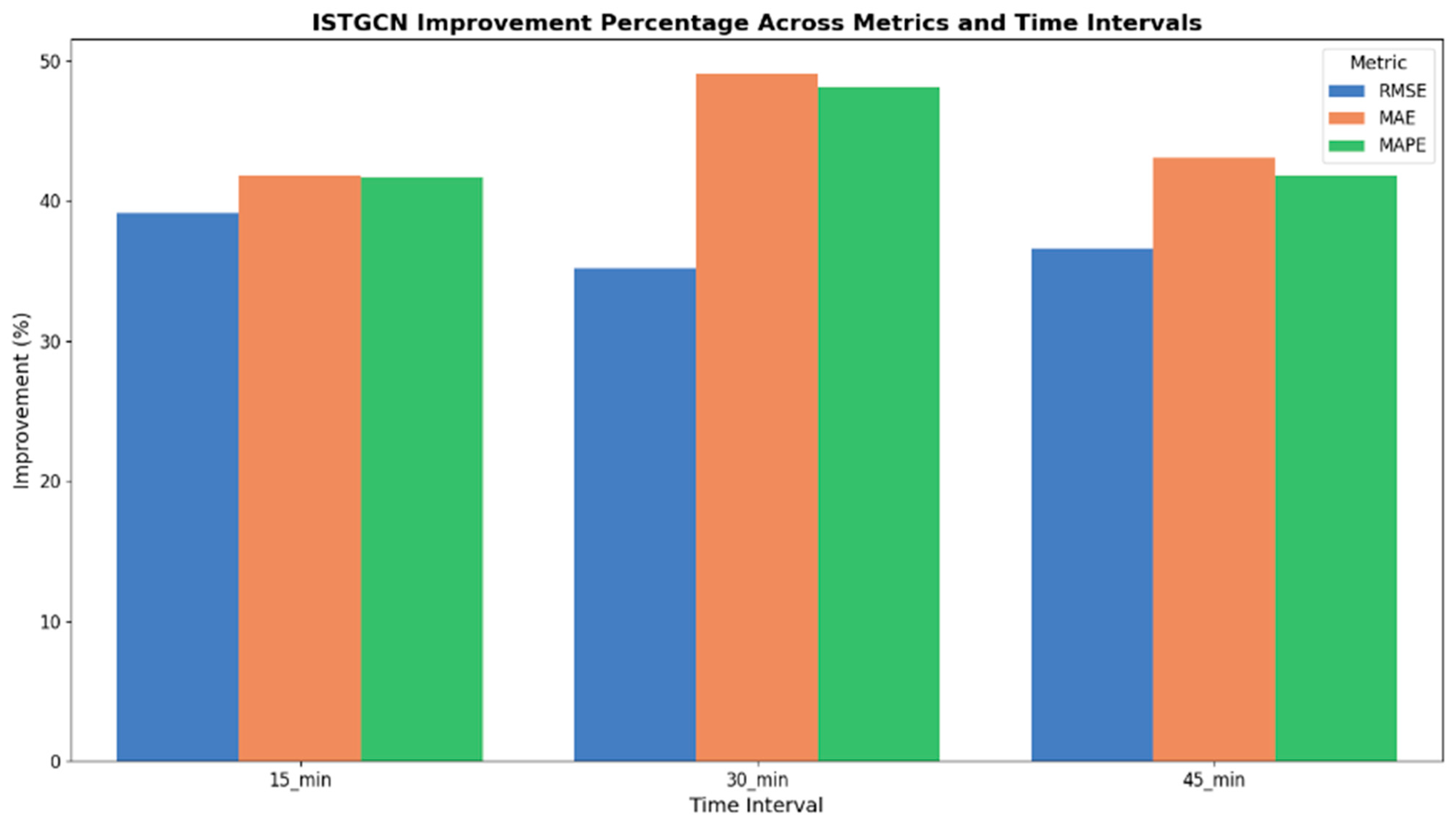
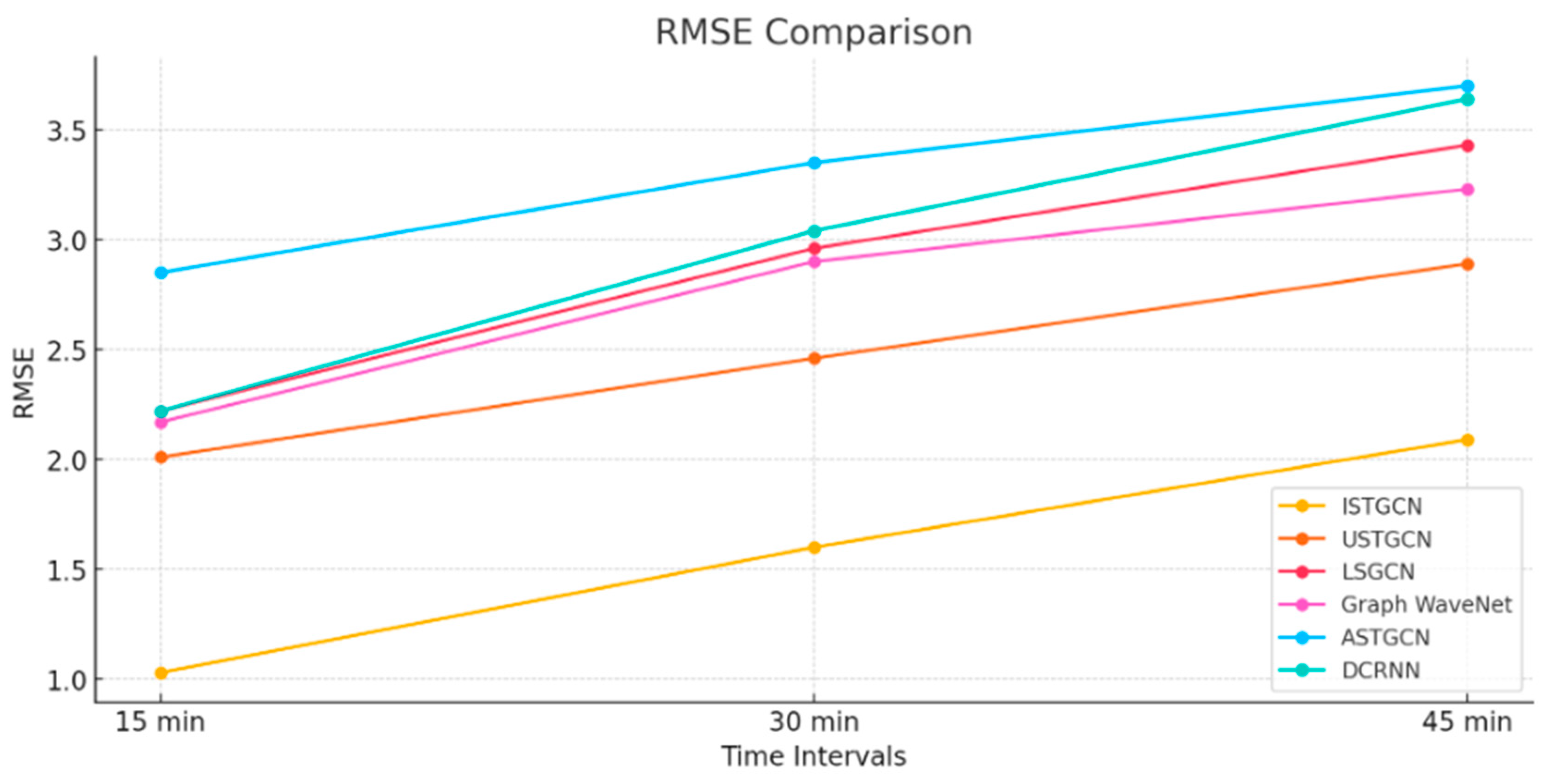
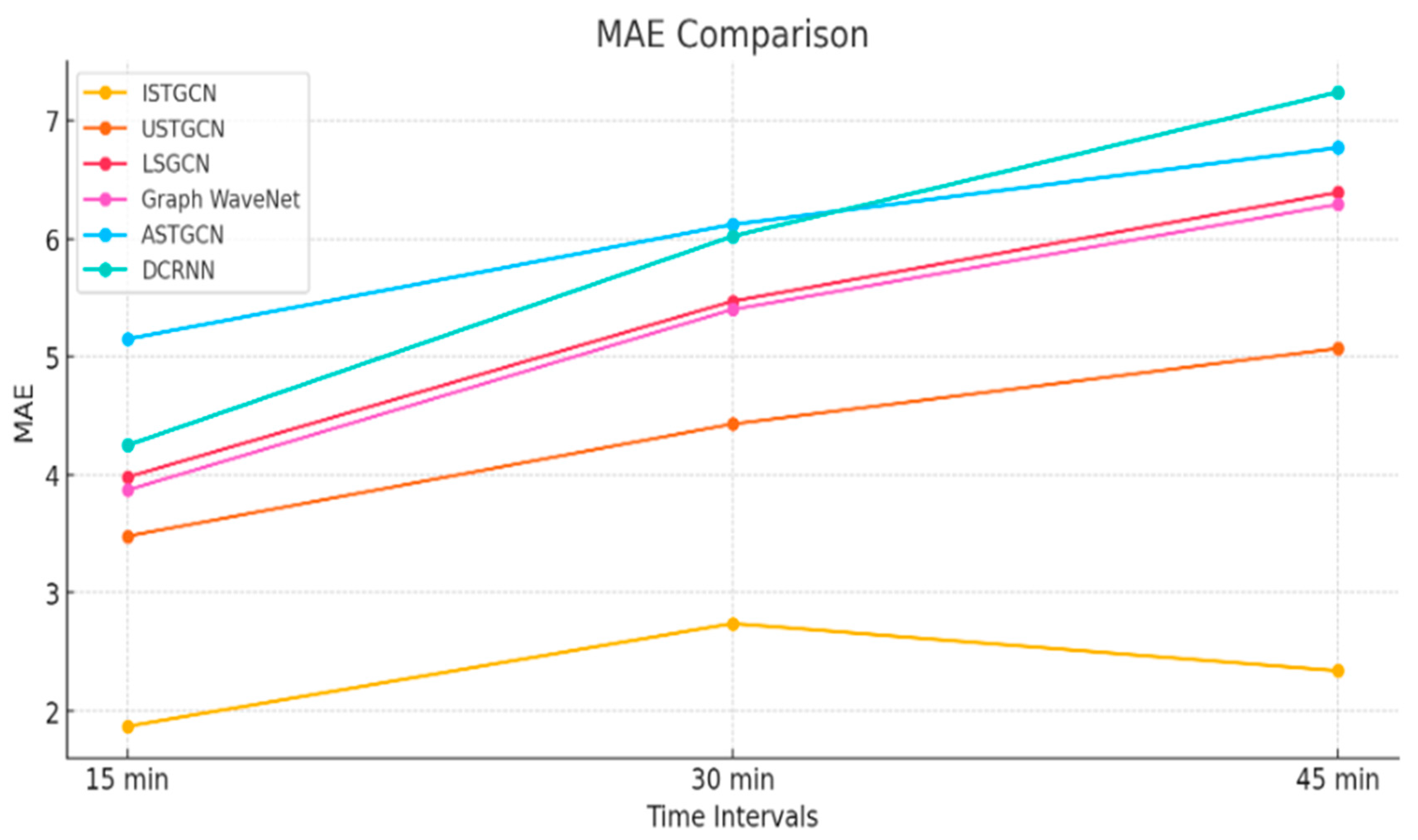
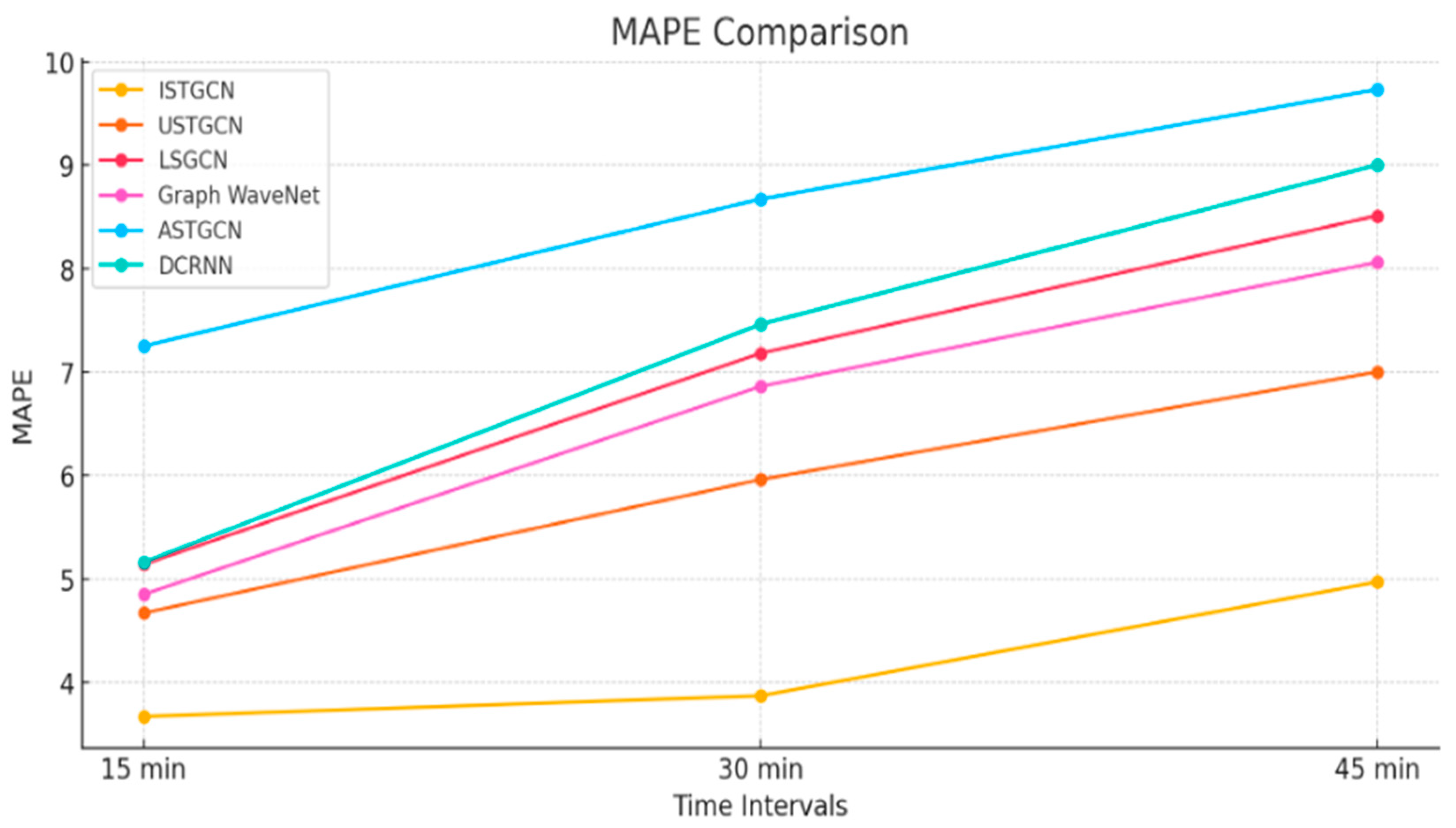
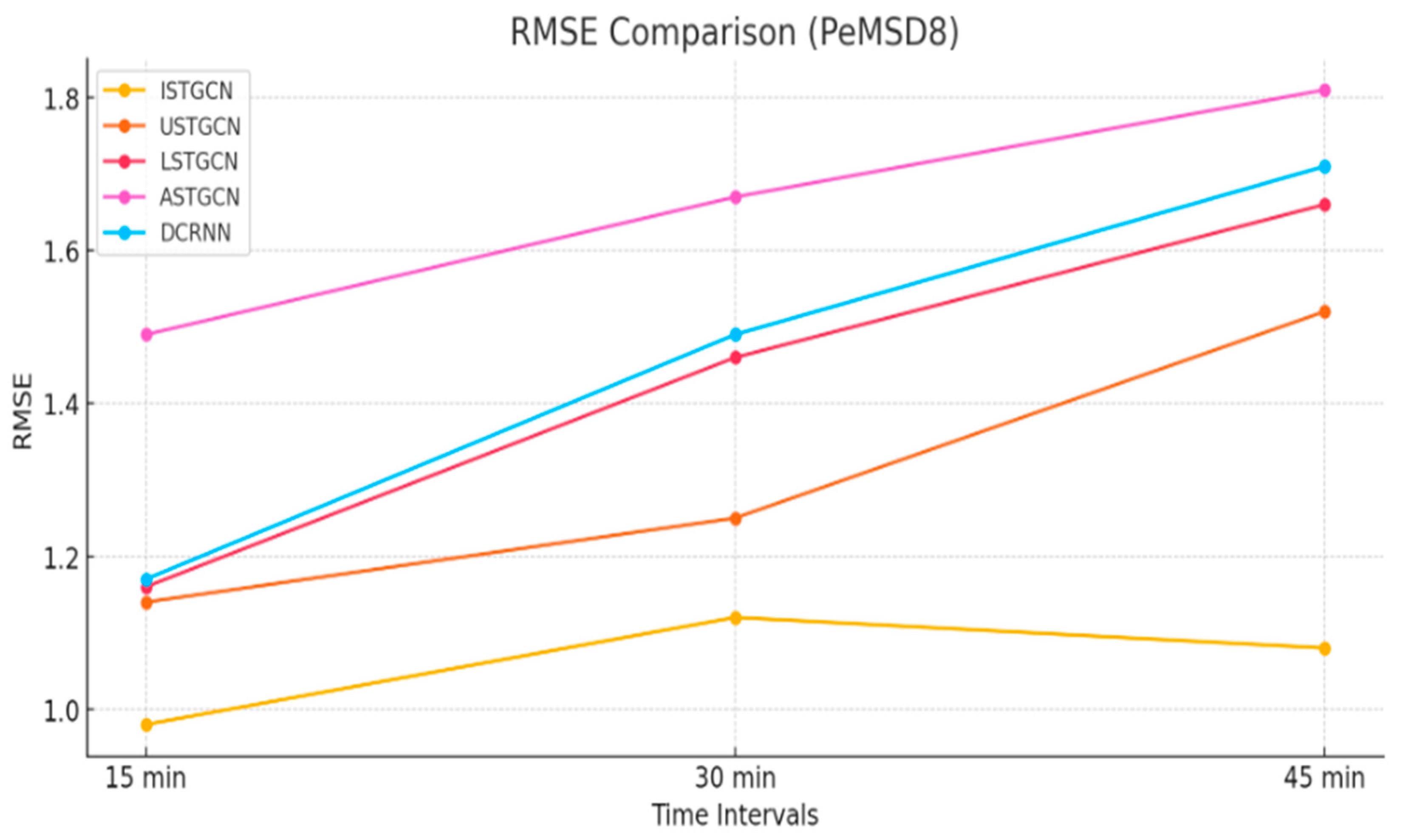
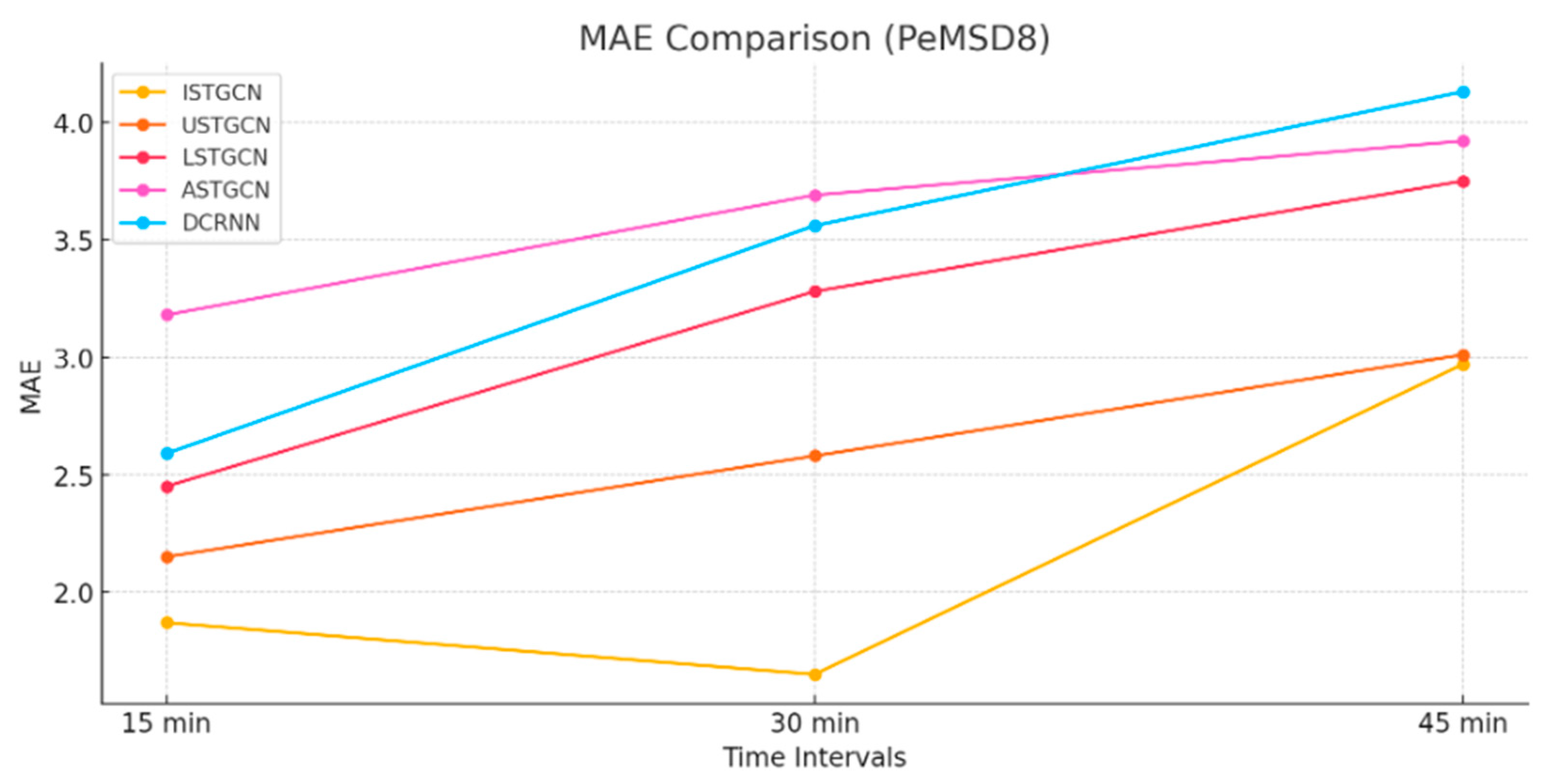
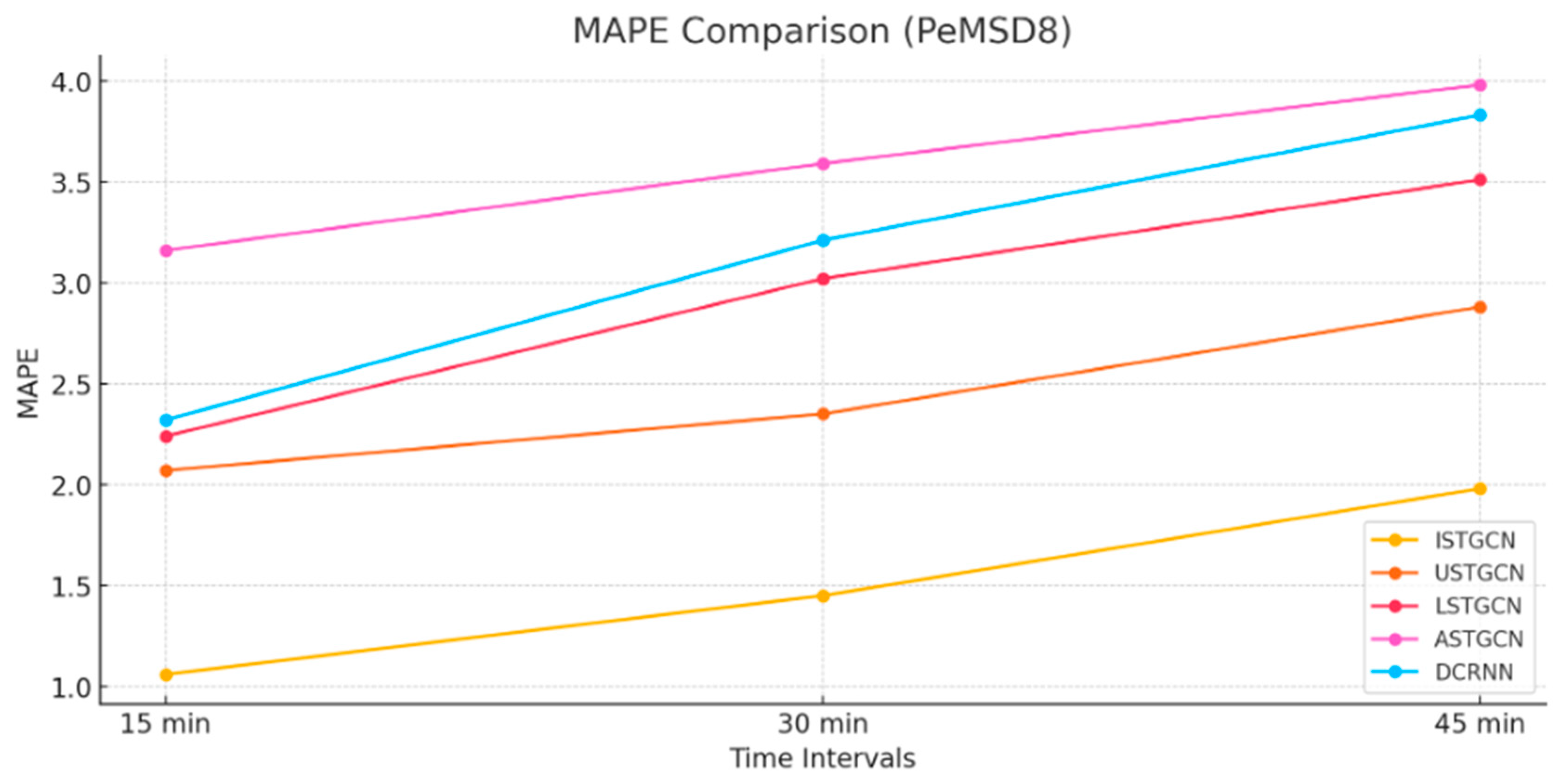
| Statistics | PeMSD7 | PeMSD8 |
|---|---|---|
| No. of nodes | 220 | 170 |
| No. of edges | 832 | 295 |
| Timestamp | 12,672 | 17,856 |
| Time interval | 5 min | 5 min |
| Daily range | 00:00–24:00 | 00:00–24:00 |
| Dataset | Model | 15 min | 30 min | 45 min | ||||||
|---|---|---|---|---|---|---|---|---|---|---|
| RMSE | MAE | MAPE | RMSE | MAE | MAPE | RMSE | MAE | MAPE | ||
| PeMSD7 | ISTGCN [Proposed] | 1.03 | 1.87 | 3.67 | 1.60 | 2.74 | 3.87 | 2.09 | 2.34 | 4.97 |
| USTGCN [36] | 2.01 | 3.48 | 4.67 | 2.46 | 4.43 | 5.96 | 2.89 | 5.07 | 7.00 | |
| LSGCN [35] | 2.22 | 3.98 | 5.14 | 2.96 | 5.47 | 7.18 | 3.43 | 6.39 | 8.51 | |
| Graph WaveNet [37] | 2.17 | 3.87 | 4.85 | 2.90 | 5.40 | 6.86 | 3.23 | 6.29 | 8.06 | |
| ASTGCN [34] | 2.85 | 5.15 | 7.25 | 3.35 | 6.12 | 8.67 | 3.70 | 6.77 | 9.73 | |
| DCRNN [38] | 2.22 | 4.25 | 5.16 | 3.04 | 6.02 | 7.46 | 3.64 | 7.24 | 9.00 | |
| PeMSD8 | ISTGCN [Proposed] | 0.98 | 1.87 | 1.06 | 1.12 | 1.65 | 1.45 | 1.08 | 2.97 | 1.98 |
| USTCGN [36] | 1.14 | 2.15 | 2.07 | 1.25 | 2.58 | 2.35 | 1.52 | 3.01 | 2.88 | |
| LSTCGN [35] | 1.16 | 2.45 | 2.24 | 1.46 | 3.28 | 3.02 | 1.66 | 3.75 | 3.51 | |
| ASTGCN [34] | 1.49 | 3.18 | 3.16 | 1.67 | 3.69 | 3.59 | 1.81 | 3.92 | 3.98 | |
| DCRNN [38] | 1.17 | 2.59 | 2.32 | 1.49 | 3.56 | 3.21 | 1.71 | 4.13 | 3.83 | |
Disclaimer/Publisher’s Note: The statements, opinions and data contained in all publications are solely those of the individual author(s) and contributor(s) and not of MDPI and/or the editor(s). MDPI and/or the editor(s) disclaim responsibility for any injury to people or property resulting from any ideas, methods, instructions or products referred to in the content. |
© 2024 by the authors. Licensee MDPI, Basel, Switzerland. This article is an open access article distributed under the terms and conditions of the Creative Commons Attribution (CC BY) license (https://creativecommons.org/licenses/by/4.0/).
Share and Cite
Singh, V.; Sahana, S.K.; Bhattacharjee, V. Integrated Spatio-Temporal Graph Neural Network for Traffic Forecasting. Appl. Sci. 2024, 14, 11477. https://doi.org/10.3390/app142411477
Singh V, Sahana SK, Bhattacharjee V. Integrated Spatio-Temporal Graph Neural Network for Traffic Forecasting. Applied Sciences. 2024; 14(24):11477. https://doi.org/10.3390/app142411477
Chicago/Turabian StyleSingh, Vandana, Sudip Kumar Sahana, and Vandana Bhattacharjee. 2024. "Integrated Spatio-Temporal Graph Neural Network for Traffic Forecasting" Applied Sciences 14, no. 24: 11477. https://doi.org/10.3390/app142411477
APA StyleSingh, V., Sahana, S. K., & Bhattacharjee, V. (2024). Integrated Spatio-Temporal Graph Neural Network for Traffic Forecasting. Applied Sciences, 14(24), 11477. https://doi.org/10.3390/app142411477







